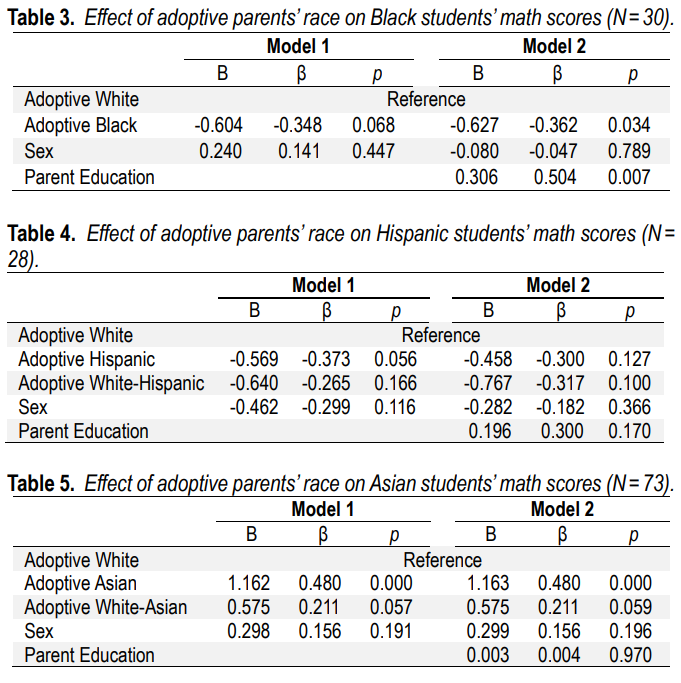Transracial adoption studies, especially ones which examine the performance of adopted blacks, are lacking since the prominent Minnesota Transracial Study of Black adoptees (Weinberg et al., 1992, Table 2). To fill this gap I analyzed the HSLS data, and found that the math abilities of transracial adoptees do not depend on the adoptive parents’ race.
Hu, M. (2023). Does Parent Education Moderate the Effect of Adoptive Parents’ Race on Math Ability?. Mankind Quarterly, 63(4).
Mathematics assessments, which provide a measure of achievement in algebraic reasoning, were used as an approximate measure of cognitive ability. Although math problem-solving is an achievement test, a study reported a correlation of 0.63 with the Raven’s Advanced Progressive Matrices (Pajares & Kranzler, 1995).
Separate regression for each race was used to compare the math abilities of adopted students by parents’ race. Because parents’ race affects math scores and parent education levels vary across parents’ race, education was used as a covariate.
The table below reports the unstandardized (B) and standardized (β) regression coefficients for the 9th grade adopted students. All analyses applied sampling weights. I cannot stress this enough, but sampling weights must be used to make inference to the population. Yet many researchers still don’t use these variables.
I suggest focusing solely on the B coefficient because, unlike β, it is not affected by standard deviations, which actually differ across groups. The dependent variable was transformed into z-score. This means the B coefficient directly gives the z-score gap for each subgroup of students adopted by same-race couples or adopted by interracial couples compared to students adopted by white couples (reference group).
We see in model 2, which introduced parent education, that the B coefficient of parents’ race categories is not reduced, implying no moderating effect on parents’ race. With the exception of the asian group, parent education had a moderate effect on math (B=0.306 for blacks and B=0.196 for hispanics).
Both the black and hispanic adoptees perform worse in math when adopted by same-race parents as opposed to white parents. The opposite was true for asian adoptees. Asians adopted by asian parents performed better than those adopted by asian-white parents. This pattern wasn’t replicated in the hispanic sample but the sample size was even smaller (N=28).
One suggestion I read on my paper is that pooling the subsamples will help avoiding non-significant coefficients. But doing so means that I will be comparing the performance of black students adopted by black parents to all-students adopted by white parents instead of black students adopted by white parents.
Overall, the finding of the lower math scores of minority students adopted by same-race parents (as opposed to white parents) seems to suggest that cultural factors between races explain the difference. A number of psychologists now argue that instead of parent education, we should investigate parental warmth and stress because these variables are likely to affect cognitive abilities. As of now though, the evidence is still ambiguous and probably supports the null hypothesis. In the paper, I also reviewed several studies, including longitudinal ones, and I did not find a strong evidence that adoption increases intelligence in the long term. The exception being the Romanian adopted children in both the English and Romanian Adoptees Study (Sonuga-Barke et al., 2017) and the Bucharest Early Intervention Project (Humphreys et al., 2022). These children however experienced severe environmental deprivation prior to adoption. This is unlikely to be the case in the HSLS sample.
The lack of information on either the HSLS students prior to adoption or their biological parents does not allow me to check for other confounding environmental effects. Previously though, I re-analyzed Willerman et al. (1974) study of the longitudinal CPP data, and the finding suggests that the positive impact of having a white mother as opposed to black mother started to vanish among biracial kids at age 7. This strongly suggests that the effect of parents’ race may not be causal.
Supplementary file: https://osf.io/x5dh3/
Discover more from Human Varieties
Subscribe to get the latest posts sent to your email.


Leave a Reply